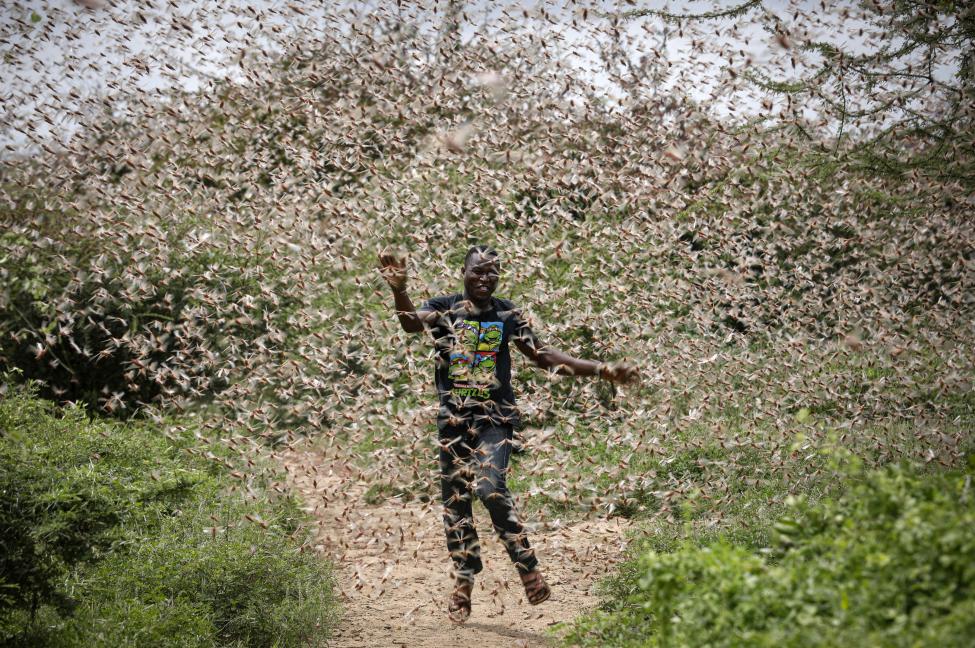In just one day, a swarm of locusts the size of Paris could eat the same amount of food as half the population of France.
And that’s pretty much exactly what has been forecast for an enormous region reaching from Somalia, Ethiopia and Kenya (hit right now) to Egypt, Sudan, Eritrea, Saudi Arabia, and Yemen.

A real plague of pests has been forecast for the region that saw unprecedented rainfall over the last three months of 2019. And according to a new United Nations report the scale of the infestation will reach well beyond the Horn of Africa, where it all started, posing “an unprecedented threat to food security and livelihoods” in the area.
Unprecedented threat in Kenya, Ethiopia, and Somalia
The issue is “extremely” acute in Kenya, Ethiopia, and Somalia, where locusts have already descended in eye-watering numbers of up to 150 million jumping critters per square kilometre (0.39 square miles).
This is the worst infestation in Ethiopia for the past 25 years, and in Kenya in 70 years.
South Sudan and Uganda are not currently affected, but are at risk.
Southwest Asia and Red Sea area also affected
Due to unusual climate conditions that have favoured rapid locust reproduction, the insect invasion has a solid chance of spreading.
A “potentially threatening situation is developing along both sides of the Red Sea, where ongoing breeding is causing locust numbers to increase on the coasts of Egypt, Sudan, Eritrea, Saudi Arabia, and Yemen.”
In addition, numerous desert locust swarms have been breeding in India, Iran and Pakistan since June 2019. And some have migrated to southern Iran where recent heavy rains have nurtured a breeding ground that could generate swarms in the spring.
Causes of locust invasion
Heavy rain in late 2019 is the primary cause for the prolific generation of locusts.
Indeed, parts of East Africa and the Sahel region have received as much as 15 inches more rain than normal in the autumn of 2019.
Warmer temperatures could also play a role in producing the frightening swarms of insects on the loose.
The agency stressed that as favourable breeding conditions continue, the increase in locust swarms could last until June. And left unchecked, the numbers of crop-devouring insects could grow 500 fold by then.
Locust plague reaches international dimensions
In a press release issued on Monday, FAO Director-General QU Dongyu said that the situation is now of “international dimensions”.
“Authorities in the region have already jump-started control activities, but in view of the scale and urgency of the threat, additional financial backing from the international donor community is needed so they can access the tools and resources required to get the job done,” Mr. Qu said.
According to the UN agency, “given the scale of the current swarms, aerial control is the only effective means to reduce the locust numbers”.
Mr. Qu also warned the response must include efforts to restore people’s livelihoods. “Communities in Eastern Africa have already been impacted by extended droughts, which have eroded their capacities to grow food and make a living. We need to help them get back on their feet, once the locusts are gone,” FAO’s Director General said.
Locust key facts
- Locusts are the oldest migratory pest in the world, form swarms and can migrate over large distances.
- The Desert Locust is the most devastating of all locust species (Schistocerca gregaria). During plagues, it can easily affect 20 percent of the Earth’s land, more than 65 of the world’s poorest countries, and potentially damage the livelihood of one tenth of the world’s population.
- Desert Locusts live in the desert areas between West Africa and India – an area of about 16 million square km where they normally survive in about 30 countries.
- Locusts have a high capacity to multiply, form groups, migrate over relatively large distances (they can fly up to 150 km per day) and, if good rains fall and ecological conditions become favourable, rapidly reproduce and increase some 20-fold in three months.
- Locust adults can eat their own weight every day, i.e. about two grams of fresh vegetation per day. A swarm the size of Bamako, Niamey or Paris will consume the same amount of food in a single day as half the population of Mali, Niger and France respectively.
- If infestations are not detected and controlled, devastating plagues can develop, with severe consequences on food security and livelihoods.
That locust plague will have unprecedented consequences on the local as well as the international food markets. We will soon feel the effects of it. Be prepared. For similar biblical headlines please visit Strange Sounds or Steve Quayle. [FAO, UN]
Follow us: Facebook and Twitter. By the way you can also support us on Paypal. Please and thank you!













And what happens when Africans – who have bred, and bred, and bred on Western compassion and stupidity – decide to migrate out of Africa, knowing that most governments won’t stop them? Will it be into a weakened Taiwan, Hong Kong, UK, and Paris? If the global economy shifts much more on the quicksand it rests on, will the swarms of migrants demanding more also flood north into the US and Canada, bringing in Eritreans and Somalis with them?
A mess. A big, fat mess of misery coming soon to you and yours. But don’t worry! Transhumanism is here – and your friendly neighborhood psycho pedo bankster holds the key to the last of the soul-sucking sounds he and all his friends make at the world.
The Four Horsemen of the Apocalypse on separate roads are now galloping and joining together at the crossroads.
OUR FATHER IN HEAVEN warned everyone WATCH THE BIRDS,the US MILITARY wants a FAMINE to happen,their using satilite weapons to kill the birds all over the world,THEIR WAY TO STUPID to understand their food will run out at some point in time and they won’t have any food either,BUT,no said americans were the sharpest knives in the drawer….OH well the RUSSIANS will deal with america soon….
Bro get your tin foil hat off your head
Mysterious death of 500 migrant birds in Mazandaran province
After the discovery of the bodies of over 500 migrant birds in Miankaleh swamp, the director of the Environmental Protection Organization of Mazandaran said the bodies belong to four different types of immigrant birds, and the reason for their deaths is currently unknown.
According to Hossein-Ali Karnami: “After witnessing the corpses of the migrant birds on Wednesday in Miankaleh swamp, agents of the Enviornmental Protection Organization were deployed to the area for closer investigation.”
Bring back DDT
Insect plagues and new out of control viruses, I think I read a book about something like this happening !
Time to start building green houses.
Locusts are a great source of energy. A person can subsist on locust and honey for quite some time. All through history they have been used as a food source.
Couldn’t people in the affected areas put up or cover plants with tiny netting, catch the locusts and then roast and eat them for food like they do in Asia?
Got to be some way to turn a predator into prey.
Tiny netting?
Just a suggestion.